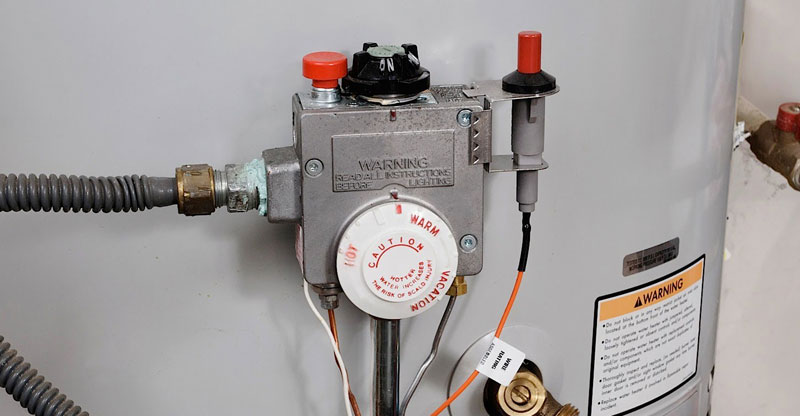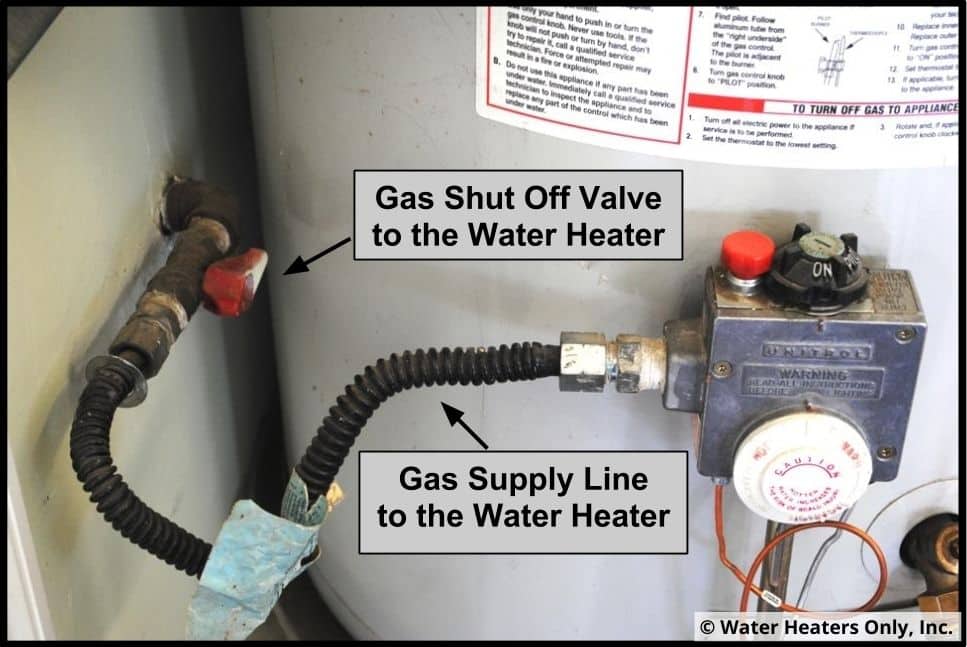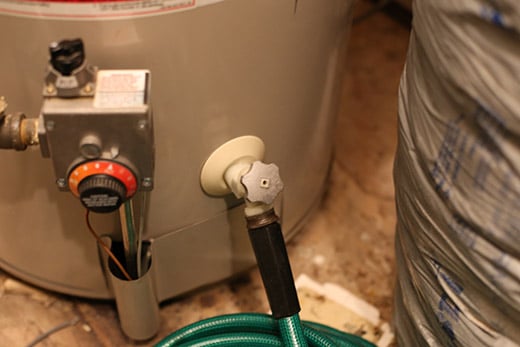clGaining familiarity with the process of switching off a gas water heater is a must-have for any homeowner. This knowledge can help you prevent potential hazards and deal with emergency situations effectively. In this guide, we’ll provide comprehensive instructions on safely shutting down your gas water heater.
We will discuss common signs of a faulty water heater, such as leaks which might indicate the need for valve replacement or professional repair services like B&L Plumbing. We’ll also explain why it’s important to clear around your water heater before turning it off and how to locate crucial components like the shut-off valve and control box.
In addition, we’ll walk you through the process of turning off your gas supply by rotating the handle of your shutoff valve until it stops. Furthermore, we will cover topics related to restarting your gas water heater after shutdown, dealing with electric water heaters, regular maintenance practices for longevity, and ensuring safety with professional help.
This guide aims not only at helping homeowners understand their appliances better but also empowering them in maintaining their homes’ safety standards. So let’s dive into learning more about how to turn off a gas water heater.
Table of Contents:
- Understanding Your Gas Water Heater
- When to Turn Off Your Gas Water Heater
- How to Safely Turn Off Your Gas Water Heater
- Restarting Your Gas Water Heater
- Dealing with Electric Water Heaters
- Regular Maintenance for Longevity
- Ensuring Safety with Professional Help
- FAQs in Relation to How to Turn Off Gas Water Heater
- Conclusion
Understanding Your Gas Water Heater
If you’re a homeowner in the Kansas City area, it’s important to know how your gas water heater works. The control box, burner, and shut-off valve are the main players in this hot water game.
The control box, aka the thermostat, tells the burner when to turn on and heat up that water. It’s like the conductor of the hot water orchestra.
The burner is the star of the show, located at the bottom of the tank. It heats up the cold water, so you can enjoy a nice, steamy shower or wash your dishes without freezing your fingers off.
And let’s not forget about the shut-off valve. It’s like the emergency brake for your gas water heater. If something goes wrong, just turn that knob and stop the gas supply in its tracks.
Oh, and there’s also a drain faucet for maintenance. Gotta keep that sediment in check, so your water heater can keep doing its job for years to come.
Knowing how these parts work together can help you take care of your water heater and catch any issues before they become big problems. Trust me, your future self will thank you.
When to Turn Off Your Gas Water Heater
There are a few scenarios when you might need to turn off your gas water heater. These include times of maintenance, interruptions in the water supply, or if you suspect a leak. Don’t let your water heater go rogue.
Identifying Potential Water Heater Issues
Leaks, irregular hot water temperature, and reduced efficiency are signs that your water heater might be up to no good. Don’t let it get away with it.
- No Hot Water: If your faucets are only serving cold water, your water heater’s burner might be slacking off.
- Inconsistent Temperature: Fluctuating temperatures? Your thermostat settings might need a reality check.
- Poor Efficiency: Waiting forever for hot water? Sediment build-up might be slowing things down.
Please note: Turning your water heater on and off too often can cause wear and tear on components like shut-off valves and control box knobs. Avoid unnecessary cycles to prevent leaks and other disasters. Safety first.
How to Safely Turn Off Your Gas Water Heater
Homeowners must be aware of how to safely turn off their gas water heater for maintenance or emergency purposes in order to avoid hazardous situations and expensive repairs. Whether it’s for maintenance or emergency situations, this knowledge can save you from potential hazards and costly repairs.
Clearing Around Your Water Heater
Before turning off your gas water heater, make sure the area is clear. Remove combustible items that could spark if they come into contact with the exposed flame of the burner. A clear space also provides easy access to the shut-off valve and control box.
Locating The Shut-Off Valve
Follow the gas pipe back from the burner until you find the knob-operated shutoff valve. If you can’t see it right away, trace the gas supply line towards where it enters your home, usually near the main gas meter.
Turning Off The Gas Valve
- To turn off the gas supply, rotate the handle of the shut-off valve 90 degrees until it stops moving.
- Check for any hissing sounds, which could indicate escaping gases. If you hear hissing, call up your local Kansas City-based B&L Plumbing services.
- If you smell natural gas after turning off all appliances, including the hot water faucet and main water supply, evacuate everyone from the house immediately. Do not use electrical switches or phones inside the building. Inform the local fire department and Kansas City’s utility company.
- If everything seems fine after these checks, congratulations. You’ve successfully turned off your home’s primary source for hot showers.
Restarting Your Gas Water Heater
If you’ve turned off your gas water heater, whether for maintenance or a temporary shut-off, restarting it is a process that requires careful attention. Here’s how to safely get your hot water flowing again.
Verify that the space around your water heater is unencumbered and secure. Ensure there are no flammable materials nearby and check that the vent hood at the top of the tank is not blocked.
To restart your gas water heater, locate the control box on the front of your unit. This should be easy to find as it’s where you initially turned off the gas supply. Turn this knob back to its original position which typically reads ‘Pilot’ or ‘On’.
The next step involves relighting the burner – but remember safety first. If you smell any hint of gas after turning on the main valve from either the gas meter or directly from the shut-off valve located near the appliance itself; immediately turn everything off and call your local gas company quickly review the situation before proceeding further.
If all smells clear though; proceed by pushing down the pilot button (usually red) while simultaneously pressing the igniter button until the flame appears under the viewing window inside the control box – usually takes about 30 seconds maximum so don’t panic if doesn’t light up instantly.
Last but not least: Once the flame has been established securely; rotate the dial back towards the ‘ON’ setting then adjust the temperature accordingly using the same dial – remembering always to keep within the manufacturer’s recommended settings for optimal performance & longevity out of machine plus safety reasons too.
Please note that once restarted successfully it may take some time for the hot water faucet to deliver warm flow due constant heating-up process happening inside the tank especially after prolonged periods of being switched off completely hence patience is required here, folks.
Key Takeaway:
To safely restart your gas water heater, make sure the area around it is clear and safe. Locate the control box on the front of the unit, turn it back to its original position, then relight the burner following safety precautions.
Dealing with Electric Water Heaters
If you’re stuck with an electric water heater instead of a gas one, don’t worry, we’ve got you covered. Shutting down and restarting these babies is a whole different ball game. Here’s what you need to know:
- Find the circuit breaker: Locate the circuit breaker dedicated to your hot water heater in your home’s electrical panel.
- Flip the switch: Turn off the power by flipping the switch for this circuit to the ‘off’ position.
- Safety first: Remember, safety is key. If you’re not confident in your electrical skills, leave it to the pros like us at B&L Plumbing.
- Flick it back on When you’re ready to restart, simply flick the corresponding switch from ‘off’ to ‘on’ in your electrical panel box. Just be patient, it might take a moment for the hot water to start flowing again.
Whether you’re dealing with a gas or electric water heater, knowing how to shut them down and start them up again is crucial for its longevity and efficiency. And if you ever need a helping hand, B&L Plumbing is here to assist homeowners across Kansas City.
Regular Maintenance for Longevity
Your home relies heavily on whether you have a gas or electric water heater. Just like any other appliance, regular maintenance is key to ensuring its longevity and optimal performance. Here at B&L Plumbing, we understand the importance of keeping your water heaters running smoothly.
The first step towards maintaining your water heater involves periodic inspections. These checks help identify potential issues before they escalate into significant problems that could lead to costly repairs or replacements.
If you have a gas water heater, inspecting the shut-off valve and control box regularly can prevent leaks and ensure efficient operation. Keep an eye on the burner as well – if it isn’t igniting properly or seems less powerful than usual, this could indicate a problem with the gas supply line.
For those with electric water heaters, make sure to check all electrical connections are secure and functioning correctly. Any loose wires can cause overheating which might damage internal components over time.
- Inspection: Our team will thoroughly review every part of your unit during our routine visits.
- Repair: If we find any issue during inspection – be it minor wear-and-tear or major malfunctioning parts – we’ll fix them promptly.
- Replacement: Sometimes repair may not be enough; in such cases where units are beyond repair due to age or extensive damage, B&L Plumbing offers replacement services too.
In addition to these steps taken by professionals from B&L Plumbing in the Kansas City area, homeowners should also remember simple tasks like draining their tank annually using the drain faucet located at the bottom of the unit to remove the sediment buildup, which hampers efficiency.
Maintenance doesn’t stop there though. Remember to always keep the area around the hot water faucet clear so that heat dissipates efficiently without causing unnecessary stress on the system itself.
Key Takeaway:
Regular maintenance is crucial for the longevity and optimal performance of your gas or electric water heater. Inspecting shut-off valves, control boxes, burners (for gas heaters), and electrical connections (for electric heaters) can help prevent leaks and ensure efficient operation. B&L Plumbing offers thorough inspections, prompt repairs, and replacement services if necessary. Additionally, homeowners should drain their tanks annually to remove sediment buildup and keep the area around the hot water faucet clear for proper heat dissipation.
Ensuring Safety with Professional Help
Your home’s plumbing system, including your gas water heater, is crucial for comfort and convenience. But dealing with these appliances can be complex and risky. That’s why it’s smart to call in the pros when you’re unsure or facing complications.
B&L Plumbing, serving the Kansas City area, has experienced professionals who handle all types of water heaters – gas or electric. Whether you need help with your water heater control box, adjusting the shut-off valve, restarting your hot water supply, or understanding the knob-operated shutoff valve, we’ve got you covered.
Safety should never be compromised when it comes to your hot water faucet or main water supply. Our experts ensure safety and efficiency every step of the way. We also provide tips on maintaining clear space around your water heater for easy access during emergencies.
If you notice any trouble, like leaks from the gas pipe back towards the burner, indicating a faulty shut-off valve, contact us right away. We’ll quickly review the issue before it gets worse.
If there’s a gas leakage issue at home due to mishandling of any appliance connected to the main gas line, contact your local gas company immediately. They’ll inspect and rectify any potential hazards related to improper usage or malfunctioning equipment.
Conclusion
Thank you for taking the time to explore our comprehensive guide on safely turning off your gas water heater. By following the step-by-step instructions provided, you can confidently and securely shut down your water heater whenever the need arises. Prioritizing safety is paramount, and we hope that this guide has empowered you with the knowledge to handle this task with confidence.
Remember, whether you’re preparing for an extended vacation, performing maintenance, or facing an emergency situation, properly turning off your gas water heater can prevent accidents and ensure the well-being of your household. Always exercise caution, adhere to the manufacturer’s guidelines, and never hesitate to seek professional assistance if you’re unsure about any steps in the process.
We encourage you to bookmark this guide for future reference and share it with friends and family, ensuring that everyone has the necessary know-how to handle their gas water heaters responsibly. Taking proactive measures to safeguard your home not only provides peace of mind but also contributes to a more secure and harmonious living environment.
Thank you for choosing our guide as your resource. Feel free to explore our other articles for more valuable insights into home maintenance and safety. Stay safe, stay informed, and enjoy the comfort and security of a well-maintained gas water heater in your home.
Related Articles:






